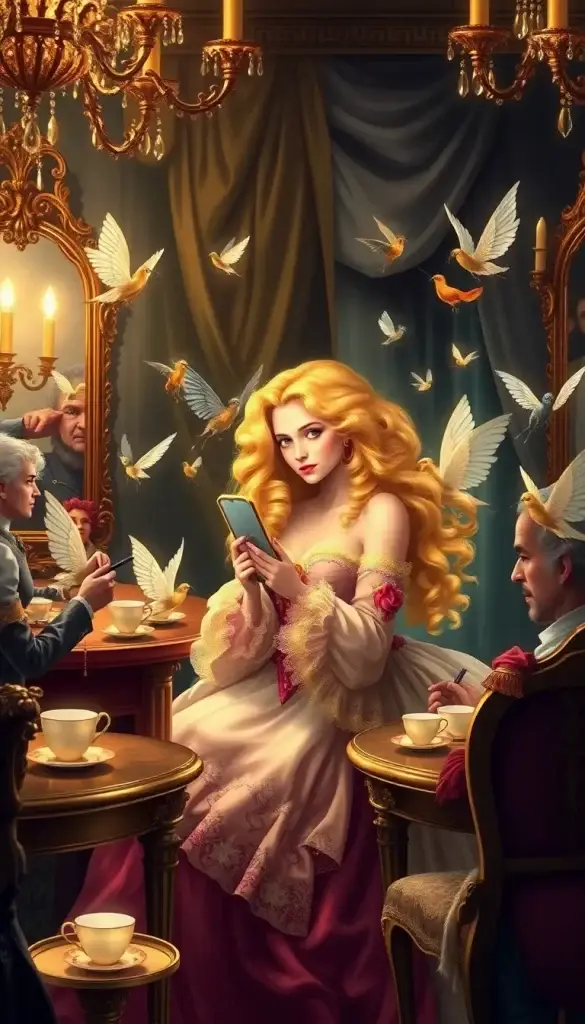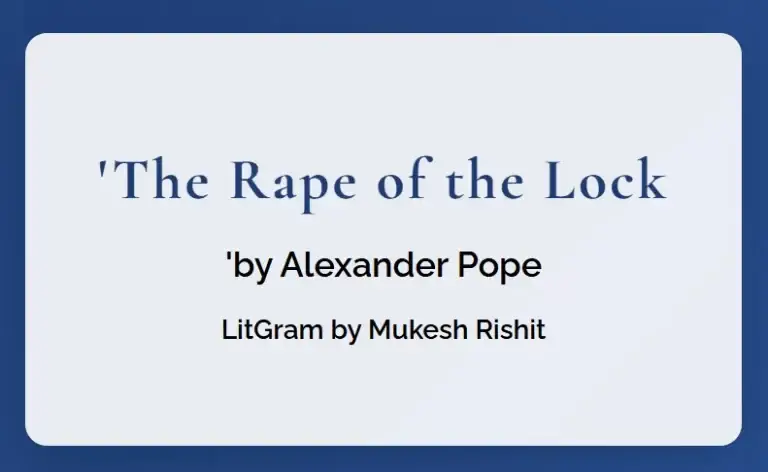Welcome to this detailed study guide on Alexander Pope‘s brilliant and enduring mock-epic poem, The Rape of the Lock. Often hailed as one of the finest examples of satire and wit in the English language, this poem takes a seemingly trivial social incident and elevates it to the grandeur of classical epic, exposing the vanities and absurdities of early 18th-century aristocratic society in the process.
Whether you’re a student encountering Alexander Pope for the first time or a seasoned reader looking for deeper analysis, this guide will navigate you through the poem’s intricate world. We will explore a detailed summary, delve into the complex characters, analyze the major themes, unpack Pope’s masterful use of the mock-epic form, and dissect his sharp satirical commentary. Prepare to be amused, enlightened, and perhaps even slightly scandalized by this dazzling literary gem.
About the Author: Alexander Pope (1688-1744)
Understanding The Rape of the Lock requires some context about its creator. Alexander Pope was the preeminent English poet of the early 18th century, a central figure of the Augustan Age. Despite facing significant challenges – his Catholic faith barred him from university and public office, and a childhood illness left him physically disabled and short-statured – Pope rose to literary stardom through sheer talent and determination.
He was renowned for his technical mastery, particularly his flawless use of the heroic couplet (rhyming pairs of iambic pentameter lines). His works are characterized by biting satire, sharp wit, intellectual depth, and moral commentary. Alexander Pope believed poetry should be both beautiful and instructive (“to delight and instruct”). His major works include An Essay on Criticism, Windsor Forest, translations of Homer’s Iliad and Odyssey, An Essay on Man, and The Dunciad. The Rape of the Lock remains his most popular and accessible work, showcasing his unique blend of humor and artistry.
Historical Context and Genesis: From Real Scandal to Mock-Epic
The Rape of the Lock wasn’t purely a product of Alexander Pope’s imagination. It was inspired by a real social incident that caused a rift between two prominent Catholic families. The young Lord Petre playfully (or perhaps presumptuously) snipped off a lock of hair belonging to the beautiful Arabella Fermor without her permission. This seemingly minor act escalated into a significant feud.
John Caryll, a mutual friend of Pope and the families involved, commissioned Alexander Pope to write a lighthearted poem about the incident. Caryll hoped that by gently mocking the situation and showing its triviality in the grand scheme of things, Pope could encourage reconciliation through laughter.
Pope initially published a two-canto version in 1712. It was well-received, but Alexander Pope felt it could be improved. In 1714, he released a significantly expanded five-canto version, adding the “supernatural machinery” of the sylphs, gnomes, nymphs, and salamanders, which further enhanced the mock-epic quality and satirical depth. This later version is the one commonly studied today.
Understanding the Mock-Epic Genre
To fully appreciate Pope’s achievement, one must understand the mock-epic (or mock-heroic) genre. It involves applying the lofty style, conventions, and grandeur of classical epic poetry (like Homer’s Iliad or Virgil’s Aeneid) to a trivial, mundane, or commonplace subject.
Key Epic Conventions Parodied by Pope:
- Invocation of the Muse: Epics begin with a call to a muse for inspiration. Alexander Pope invokes his own muse (likely Caryll initially) but frames the subject as trivial (“What dire offence from am’rous causes springs, / What mighty contests rise from trivial things”).
- Statement of Theme: Grand themes of war, fate, and heroism are replaced by social squabbles.
- Supernatural Machinery: Gods and goddesses interfering in human affairs are replaced by tiny, elemental spirits (sylphs, gnomes) concerned with fashion, flirtation, and female vanity.
- Epic Battles: Heroic warfare is parodied in the intense card game of Ombre (Canto III) and the chaotic “battle” between the sexes (Canto V).
- Arming of the Hero: Achilles’ divine armor is replaced by Belinda’s elaborate dressing table ritual (the “toilette”) where cosmetics and accessories become her “weapons” (Canto I).
- Epic Journey/Descent into Underworld: Odysseus’s journey to Hades is mirrored by Umbriel’s descent into the gloomy “Cave of Spleen” (Canto IV).
- Grand Speeches: Characters deliver formal, elevated speeches about trivial matters (e.g., Thalestris’s outrage, Clarissa’s moralizing).
- Epic Similes: Extended, elaborate similes comparing the mundane to the magnificent, often with ironic effect.
- Elevated Language: Using formal, Latinate diction and complex sentence structures to describe everyday events.
The purpose of the mock-epic is primarily satire. By juxtaposing the grand style with the petty subject matter, Pope highlights the absurdity, vanity, and misplaced priorities of the society he depicts.
Detailed Summary: Canto by Canto
The Rape of the Lock is divided into five cantos:
Canto I: The Morning Ritual
- The poem begins around noon (“Sol through white curtains shot a tim’rous ray”). Belinda, the beautiful protagonist, is still asleep.
- She dreams of a handsome youth who reveals himself to be Ariel, her guardian sylph (an airy spirit). Ariel explains that beautiful women are protected by an army of invisible spirits derived from the elements – fiery Salamanders (passionate women), watery Nymphs (easy-going women), earthy Gnomes (melancholy or mischievous women), and airy Sylphs (flirtatious but chaste women).
- Ariel warns Belinda that some “dread event” looms, though its exact nature is unclear, likely threatening her honour or her prized possessions.
- Belinda awakens to her lapdog, Shock, licking her face, and reads a billet-doux (love letter).
- The scene shifts to Belinda’s dressing table (“toilette”). This is described as a sacred ritual, with cosmetics, pins, combs, and jewels laid out like religious or military artifacts. Belinda, assisted by her maid Betty, prepares herself for the day, effectively “arming” herself with beauty. Pope calls this the “sacred rites of Pride.”
Canto II: The Thames Journey and the Baron’s Plot
- Belinda, now radiant, travels by boat on the River Thames to Hampton Court Palace, a popular aristocratic gathering place. Her beauty captivates all onlookers.
- Her most striking features are her two beautiful locks of hair curling down her neck.
- We are introduced to the Baron, a young nobleman captivated by Belinda’s locks. He is determined to possess one (“By force to ravish, or by fraud betray”).
- The Baron performs a mock-heroic ritual, building an altar of French romances and love tokens, and praying for success in his “quest.”
- Meanwhile, Ariel, sensing danger, summons his legions of sylphs. He assigns them specific duties to protect Belinda: guarding her fan, her earrings, her watch, her lapdog, and, most importantly, her hair – particularly the lock the Baron covets.
- Ariel warns that any sylph who fails in their duty will face dire punishments (like being dipped in chocolate or stuck with pins). However, he adds a crucial caveat: the sylphs can only protect a woman who genuinely desires to remain chaste. If Belinda secretly desires the Baron’s attention (“An earthly Lover lurking at her heart”), their power is nullified.
Canto III: The Card Game and the Crime
- The scene shifts to Hampton Court Palace, where the aristocrats engage in gossip, flirting, and games.
- Belinda joins two gentlemen for a game of Ombre, a popular card game. Pope describes the game using epic battle terminology, with cards as soldiers, suits as battalions, and tricks as combat victories. Belinda plays skillfully and eventually wins.
- Coffee is served (another social ritual described with mock-gravity). The fumes supposedly inspire the Baron’s final resolve.
- Clarissa, another young lady (who later delivers a moral speech), discreetly hands the Baron a pair of scissors (“two-edg’d weapon”).
- As Belinda leans over to sip her coffee, the Baron, despite the sylphs’ frantic but ultimately ineffective attempts to intervene (Ariel tries to pull her hair, another sylph flutters in her ear), snips off one of the precious locks.
- Ariel retreats, realizing Belinda may have harbored a hidden desire (“An earthly Lover lurking at her heart”).
- The Baron exults triumphantly, while Belinda lets out a piercing scream that echoes through the palace.
Canto IV: Grief, Rage, and the Cave of Spleen
- Belinda’s distress is immense, far exceeding the actual value of the lost hair.
- A melancholy gnome named Umbriel descends to the “Cave of Spleen” (Spleen being the 18th-century term for ill-humor, melancholy, and vapours, often associated with women).
- The cave is populated by personified forms of Affectation, Ill-Nature, migraines, and female woes. Umbriel requests from the Queen of Spleen a bag filled with “sighs, sobs, and passions, and the war of tongues,” and a vial of tears.
- Umbriel returns and pours the contents of the bag and vial over Belinda, intensifying her grief and rage.
- Belinda’s friend, Thalestris, delivers a fiery speech, lamenting the potential damage to Belinda’s reputation and social standing. She worries society will think Belinda secretly allowed the lock to be cut.
- Thalestris urges her beau, Sir Plume, known for his fashionable snuffbox and cane, to demand the lock back from the Baron. Sir Plume makes a weak, ineffectual demand (“‘Gad Zooks! demand the Hair?'”), which the Baron dismisses contemptuously.
Canto V: The Battle and the Apotheosis
- The Baron remains defiant, refusing to return the lock.
- Clarissa, the lady who provided the scissors, now delivers a speech urging good sense and perspective. She questions why beauty is prized above virtue and good humor, arguing that women should focus on inner qualities rather than fleeting appearances. Her advice, however, is largely ignored (“But Clarissa’s advice was lost in the air”).
- Belinda rejects Clarissa’s counsel and demands the lock back. A chaotic “battle” ensues between the beaux (men) and the belles (women). Fans clash with snuffboxes, hairpins become daggers, and frowns and glances are the weapons. Pope describes this melee with epic hyperbole.
- Belinda confronts the Baron, throws snuff into his face, causing him to sneeze uncontrollably, and threatens him with a hairpin.
- In the confusion, the precious lock disappears. It cannot be found anywhere.
- The poem concludes with the suggestion that the lock has ascended to the heavens, becoming a new star or constellation (an apotheosis), immortalized for all to see. The Muse declares that Belinda’s name will live on through the poem and the star, outlasting the transient vanities of society.
Character Analysis
Pope’s characters are less deep psychological portraits and more brilliant satirical types representing aspects of aristocratic society.
- Belinda: The poem’s heroine. She embodies feminine beauty, charm, and vanity. Her world revolves around social rituals, appearance, and flirtation. Her distress over the lock, while exaggerated, reflects the societal pressure on women to maintain their beauty and reputation above all else. She is both a victim and a product of her superficial world.
- The Baron: The antagonist. He represents masculine arrogance, entitlement, and the trivial pursuits of the idle aristocracy. His desire for the lock is portrayed as a mock-heroic quest for a trophy, reducing female beauty to an object to be conquered and possessed.
- Ariel: The chief Sylph guarding Belinda. He represents the airy, superficial, and ultimately ineffective forces concerned with protecting female chastity and appearance externally. His powerlessness when Belinda harbors “an earthly lover” suggests the limitations of focusing solely on outward propriety.
- Umbriel: The dusky Gnome. He represents the darker side of the female psyche (as perceived in the 18th century) – melancholy, ill-temper, self-pity, and hysteria (the “spleen”). His journey to the Cave of Spleen is a brilliant satirical creation.
- Clarissa: Added in the 1714 version, Clarissa acts as Pope’s mouthpiece, offering a moral counterpoint to the surrounding vanity. Her speech in Canto V advocates for good sense, inner virtue, and perspective, though it falls on deaf ears within the poem’s world, highlighting the society’s resistance to reason.
- Thalestris: Belinda’s fiery friend. She represents concern for social reputation and honor, perhaps even more than Belinda herself. She fuels the conflict by emphasizing the social implications of the lock’s theft, showing how social codes can escalate trivial matters.
- Sir Plume: Thalestris’s beau. A caricature of the fashionable but ineffectual fop, more concerned with his appearance (snuffbox, cane) and fashionable oaths than effective action. He satirizes male posturing.
- The Sylphs and Gnomes: This “supernatural machinery” parodies the gods of epic. They are elemental spirits reflecting the preoccupations of the society Pope satirizes: Sylphs (air) manage flirtation and vanity; Gnomes (earth) manage ill-humor and affectation.

Major Themes Explored
The Rape of the Lock is rich with thematic depth beneath its glittering surface:
- Triviality vs. Importance (Lack of Proportion): This is central. The poem satirizes the tendency of high society to treat minor social incidents (like cutting a lock of hair) with the gravity of epic events, while ignoring genuine moral or intellectual concerns.
- Vanity and the Cult of Appearance: The poem mercilessly exposes the obsession with external beauty, fashion, and social rituals. Belinda’s toilette, the description of her beauty, and the value placed on the lock all highlight this superficiality.
- The Battle of the Sexes: The conflict between Belinda and the Baron serves as a microcosm of the complex, often antagonistic, relationship between men and women in this society, governed by codes of flirtation, honor, and reputation.
- Social Satire: Pope critiques the idleness, gossip, artificiality, and misplaced values of the early 18th-century aristocracy. Hampton Court Palace becomes a symbol of this frivolous world.
- Appearance vs. Reality: The polished, elegant surface of society masks underlying pettiness, envy, and aggression. The sylphs’ concern for outward chastity versus inner desire touches on this theme.
- The Role of Women: The poem reflects (and critiques) the limited roles available to aristocratic women, primarily centered on beauty, marriage, and social maneuvering. Clarissa’s speech offers an alternative but is ultimately dismissed.
- Humor and Good Sense: Through Clarissa and the poem’s overall witty tone, Pope suggests that humor, perspective, and good sense are essential for navigating social conflicts and seeing beyond superficiality.
Literary Techniques and Style: Pope’s Poetic Arsenal
Pope’s technical brilliance is on full display:
- Heroic Couplets: The entire poem is written in perfectly balanced, rhyming iambic pentameter couplets. This form lends a sense of order, elegance, and epigrammatic wit, ironically contrasting with the trivial subject matter.
- Zeugma: A figure of speech where one word (usually a verb or adjective) applies to two others in different senses. Pope uses this masterfully for ironic effect, e.g., “Or stain her honour, or her new brocade” (Canto II) or “Dost sometimes counsel take – and sometimes Tea” (Canto III). This yokes together the significant and the trivial, highlighting society’s skewed values.
- Antithesis: The juxtaposition of contrasting ideas, often balanced in parallel structures, creating sharp, memorable lines (e.g., “Resolved to win, he meditates the way, / By force to ravish, or by fraud betray”).
- Elevated Diction and Grand Language: Pope employs vocabulary and sentence structures typical of classical epics (“dire offence,” “mighty contests,” “arms,” “altar”) to describe mundane activities, creating humorous incongruity.
- Parody: The poem constantly parodies specific epic conventions (invocations, battles, journeys, supernatural beings) for satirical effect.
- Wit and Irony: Pope’s sharp intelligence permeates the poem. Irony (saying the opposite of what is meant, or highlighting discrepancies between appearance and reality) is a key tool in his satirical arsenal.
- Allusion: Frequent references to classical mythology, biblical stories, and epic literature add layers of meaning and enhance the mock-epic quality.
Why “The Rape of the Lock” Still Resonates Today
Despite being rooted in a specific 18th-century context, The Rape of the Lock remains relevant and widely studied for several reasons:
- Masterclass in Satire: It’s arguably the finest mock-epic poem in English, demonstrating how wit and humor can be powerful tools for social commentary.
- Timeless Human Foibles: While the specific customs have changed, the poem’s core themes – vanity, social posturing, the battle of the sexes, blowing things out of proportion – are enduring aspects of human nature.
- Poetic Artistry: It showcases Pope’s unparalleled mastery of the heroic couplet and his dazzling linguistic dexterity.
- Historical Insight: It provides a vivid, albeit satirical, window into the manners, values, and preoccupations of the English aristocracy during the Augustan Age.
- Engaging Narrative: Despite its complex language and structure, the poem tells a clear, amusing story with memorable characters.
Conclusion: A Lock on Immortality
Alexander Pope’s The Rape of the Lock is far more than just a witty poem about a stolen curl. It is a sophisticated critique of a society obsessed with surfaces, a masterful deployment of the mock-epic form, and a testament to the power of satire to both amuse and instruct. Through Belinda, the Baron, and the shimmering, bustling world they inhabit, Pope explores timeless human vanities and the often-absurd drama of social life.
By elevating a trivial spat to epic proportions, he paradoxically cuts aristocratic pretensions down to size. The poem, like Belinda’s lock transformed into a star, achieves a lasting brilliance, securing Pope’s and its own place in the literary firmament. This study guide provides a map, but the true treasure lies in reading and re-reading Pope’s dazzling lines yourself.


